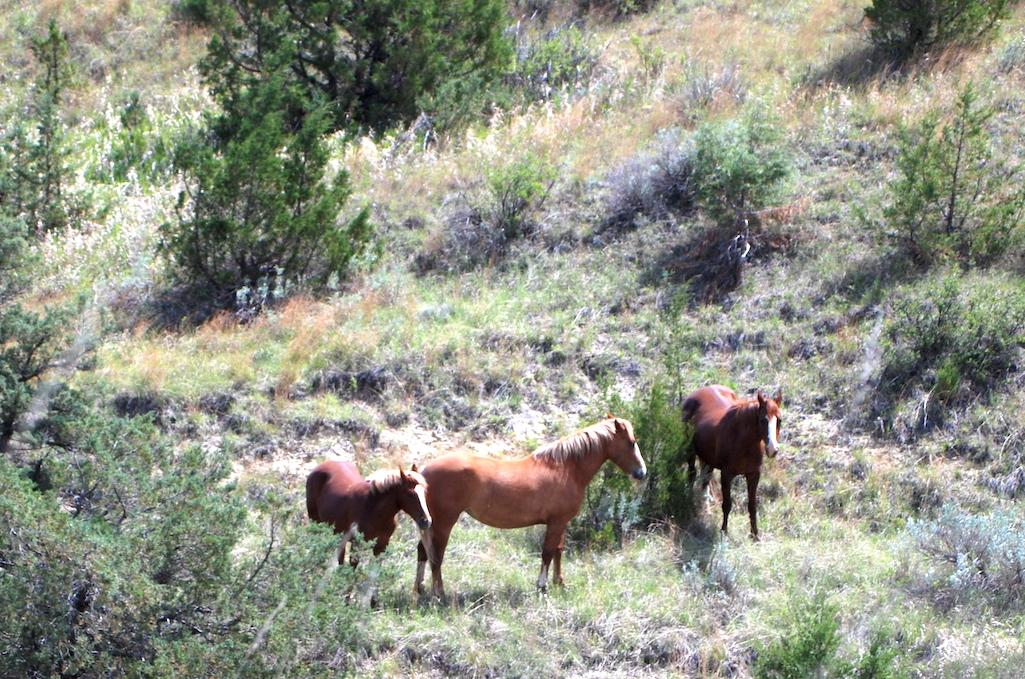
What should be done with the feral horses that reside in Theodore Roosevelt National Park?/Kurt Repanshek file
The National Park Service is charged with preserving natural resources, a challenging mission at best, but one that can get emotionally charged when the topic of removing nonnative horses and cattle comes up. At Theodore Roosevelt National Park in North Dakota, officials are gathering public comment on what to do with the roughly 200 feral horses and nine cattle that roam that park.
The park hasn't updated its horse management plan since 1978, and its cattle management plan dates to 1970. Now the staff is considering three options:
1) Continue to follow those plans;
2) Remove the feral horses and cattle as quickly as possible;
3) Remove the cattle, and reduce the horse herd significantly to a number of "fully contracepted horses" that would be allowed to live out their lives in the park.
A virtual public scoping meeting is scheduled for January 12, 2023. Attendees can join by computer or phone to learn about the Livestock Plan.
Public comment on the alternatives is being taken through January. You can find details on the plan and leave your comments at this site.

 Support Essential Coverage of Essential Places
Support Essential Coverage of Essential Places




Comments
They are not 'feral'. This is a derogatory term. They are a wild, indigenous sepcies. Yes, indigenous. The horse is native to North America. This is now being proven with DNA. If you want to cling to your outdated, cattle-industry bought 'studies', you are falling for lies. These horse are magnificent and benefit the environment, the cattle do not and the cattle shoud be removed. I will never set foot in this park again if this abomination is allowed.
thank you for asking for public comments. I hope you will be able to keep the horses. Wasn't it Theodore Roosevelt himself who loved horses so much? What would it take to keep them?
Some 10 million years ago, up to a dozen species of horses roamed the Great Plains of North America. These relatives of the modern horse came in many shapes and sizes. Some lived in the forest, while others preferred open grassland. ( https://www.amnh.org/exhibitions/horse/the-evolution-of-horses )
Growing up in western ND, we would go to the settler picnics, and powwows, my grandfather, the old cowboys and the Native Americans told us stories about the wild horses and where they came from. They came to the Badlands from the Native Americans, early settlers, and the Army. Our family would enjoy the day looking for the wild horses and having a picnic. So the horses were there before ND became a state or there was a park or park service.
I have seen horses removed in a different state for the simple reason that there is not enough grass to feed them, only to see sheep grazing there within days after the horses were removed.
Like I said horses were there before ND became a state or there was a park or park service. Why are they not grandfathered in? If they are not entitled to be there nor should humans, close the park, and remove all signs of human existence.
You are so right!! TRNP has removed several horses over the years and have people working hard to get them all adopted when they are removed. Theses people have worked wonders and the horses have thankfully found wonderful homes. The park also culls elk every few years - I think in 2022 they opened applications to injured military for the culling program. I believe they also relocated 100 bison in 2022. This has been working for the park and it's something they should continue doing. Complete removal, as you said will not only cause problems, but will have a huge impact on their tourism.
The horses of Theodore National Park belong there. Considering the size of the Park 200 horses will not overrun the eco-system. They are attractive and exciting to visitors and have a place in the Park's food chain. Please do not allow the bureaucrats to prevail.
Surely the park's wildlife management people can determine the right number of wild horses to maintain a good balance. The horses' popularity with visitors shouldn't be ignored.
The horses should stay in the park. There is enough range and grass to maintain the populations of animals in the park, as evidenced in the past.